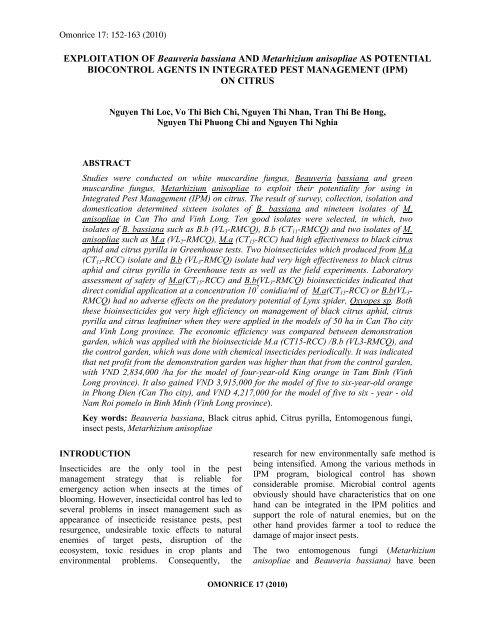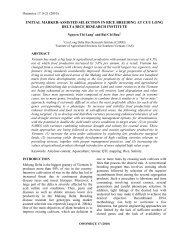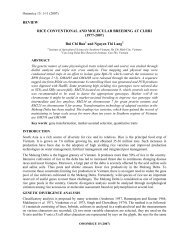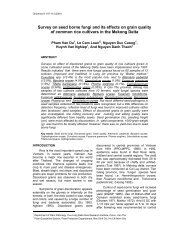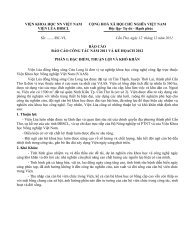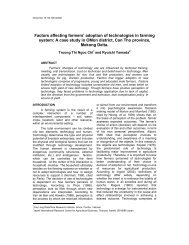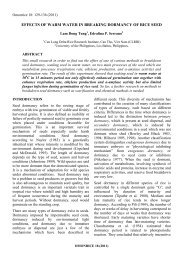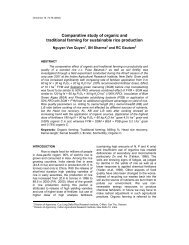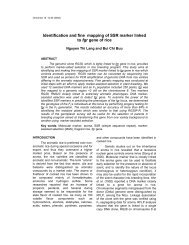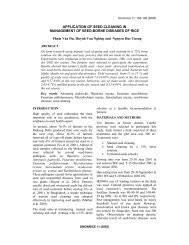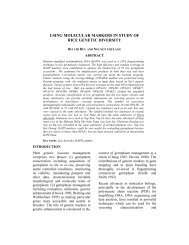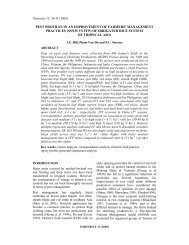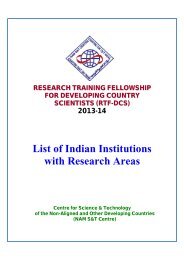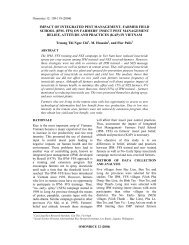EXPLOITATION OF Beauveria bassiana AND Metarhizium ...
EXPLOITATION OF Beauveria bassiana AND Metarhizium ...
EXPLOITATION OF Beauveria bassiana AND Metarhizium ...
Create successful ePaper yourself
Turn your PDF publications into a flip-book with our unique Google optimized e-Paper software.
Omonrice 17: 152-163 (2010)<br />
<strong>EXPLOITATION</strong> <strong>OF</strong> <strong>Beauveria</strong> <strong>bassiana</strong> <strong>AND</strong> <strong>Metarhizium</strong> anisopliae AS POTENTIAL<br />
BIOCONTROL AGENTS IN INTEGRATED PEST MANAGEMENT (IPM)<br />
ON CITRUS<br />
Nguyen Thi Loc, Vo Thi Bich Chi, Nguyen Thi Nhan, Tran Thi Be Hong,<br />
Nguyen Thi Phuong Chi and Nguyen Thi Nghia<br />
ABSTRACT<br />
Studies were conducted on white muscardine fungus, <strong>Beauveria</strong> <strong>bassiana</strong> and green<br />
muscardine fungus, <strong>Metarhizium</strong> anisopliae to exploit their potentiality for using in<br />
Integrated Pest Management (IPM) on citrus. The result of survey, collection, isolation and<br />
domestication determined sixteen isolates of B. <strong>bassiana</strong> and nineteen isolates of M.<br />
anisopliae in Can Tho and Vinh Long. Ten good isolates were selected, in which, two<br />
isolates of B. <strong>bassiana</strong> such as B.b (VL 3 -RMCQ), B.b (CT 11 -RMCQ) and two isolates of M.<br />
anisopliae such as M.a (VL 2 -RMCQ), M.a (CT 15 -RCC) had high effectiveness to black citrus<br />
aphid and citrus pyrilla in Greenhouse tests. Two bioinsecticides which produced from M.a<br />
(CT 15 -RCC) isolate and B.b (VL 3 -RMCQ) isolate had very high effectiveness to black citrus<br />
aphid and citrus pyrilla in Greenhouse tests as well as the field experiments. Laboratory<br />
assessment of safety of M.a(CT 15 -RCC) and B.b(VL 3 -RMCQ) bioinsecticides indicated that<br />
direct conidial application at a concentration 10 7 conidia/ml of M.a(CT 15 -RCC) or B.b(VL 3 -<br />
RMCQ) had no adverse effects on the predatory potential of Lynx spider, Oxyopes sp. Both<br />
these bioinsecticides got very high efficiency on management of black citrus aphid, citrus<br />
pyrilla and citrus leafminer when they were applied in the models of 50 ha in Can Tho city<br />
and Vinh Long province. The economic efficiency was compared between demonstration<br />
garden, which was applied with the bioinsecticide M.a (CT15-RCC) /B.b (VL3-RMCQ), and<br />
the control garden, which was done with chemical insecticides periodically. It was indicated<br />
that net profit from the demonstration garden was higher than that from the control garden,<br />
with VND 2,834,000 /ha for the model of four-year-old King orange in Tam Binh (Vinh<br />
Long province). It also gained VND 3,915,000 for the model of five to six-year-old orange<br />
in Phong Dien (Can Tho city), and VND 4,217,000 for the model of five to six - year - old<br />
Nam Roi pomelo in Binh Minh (Vinh Long province).<br />
Key words: <strong>Beauveria</strong> <strong>bassiana</strong>, Black citrus aphid, Citrus pyrilla, Entomogenous fungi,<br />
insect pests, <strong>Metarhizium</strong> anisopliae<br />
INTRODUCTION<br />
Insecticides are the only tool in the pest<br />
management strategy that is reliable for<br />
emergency action when insects at the times of<br />
blooming. However, insecticidal control has led to<br />
several problems in insect management such as<br />
appearance of insecticide resistance pests, pest<br />
resurgence, undesirable toxic effects to natural<br />
enemies of target pests, disruption of the<br />
ecosystem, toxic residues in crop plants and<br />
environmental problems. Consequently, the<br />
research for new environmentally safe method is<br />
being intensified. Among the various methods in<br />
IPM program, biological control has shown<br />
considerable promise. Microbial control agents<br />
obviously should have characteristics that on one<br />
hand can be integrated in the IPM politics and<br />
support the role of natural enemies, but on the<br />
other hand provides farmer a tool to reduce the<br />
damage of major insect pests.<br />
The two entomogenous fungi (<strong>Metarhizium</strong><br />
anisopliae and <strong>Beauveria</strong> <strong>bassiana</strong>) have been<br />
OMONRICE 17 (2010)
Exploitation of <strong>Beauveria</strong> <strong>bassiana</strong> and <strong>Metarhizium</strong> anisopliae ...<br />
153<br />
studied and applied to manage various insect pests<br />
on many crops around the world (Rombach et al.<br />
1986a and b; Aguda et al. 1987, 1988;<br />
Ramamohan Rao 1989; Butt and Copping 2000;<br />
Goettel et al. 2000; Nugroho and Ibrahim 2007<br />
and Yubak et al. 2008.<br />
In Vietnam, <strong>Metarhizium</strong> anisopliae and<br />
<strong>Beauveria</strong> <strong>bassiana</strong> have been studied and applied<br />
in controlling of rice Brown planthoppers, rice<br />
bug, coconut beetle, grasshoppers, termite etc.<br />
(Chinh et al. 2001; Thuy et al. 2001; Loc 1995,<br />
1997a and b; Loc et al. 1999, 2001, 2002, 2004,<br />
2005).<br />
Citrus are main fruit in agriculture production in<br />
the Mekong Delta. The Citrus pyrilla (Diaphorina<br />
citri) is a most serious sucking insect pest of<br />
citrus-tree in the world as well as in Vietnam. It is<br />
a vector transferring Liberobacter asiaticum<br />
bacterium causes greening disease, the main<br />
damage of citrus-tree group. The Black citrus<br />
aphid (Toxoptera sp.) is also an important pest<br />
sucking the sap of the citrus young shoots and<br />
leading deformation of citrus shoot. Thereafter,<br />
leaves are twisted, stunted and no fully<br />
development is expected. Black citrus aphid is a<br />
vector to transfer the “Tristeza” disease of citrus.<br />
The farmers in Cuu Long delta who are cultivating<br />
citrus-tree group always spray insecticides every<br />
15 days to control these two serious sucking<br />
insects.<br />
The microclimate occurred in the citrus gardens<br />
would be quite suitable for the fungal disease<br />
development and moreover the cadaver of insect is<br />
followed by external sporulation which helps<br />
fungus to be spread in very high levels to kill<br />
insects. Unlike bacteria or virus, fungi penetrate<br />
actively and do not require ingestion to infect,<br />
thus, the fungi have a better prospect in the<br />
microbial control of sucking insect pests of citrus.<br />
Therefore, the project “Exploitation of <strong>Beauveria</strong><br />
<strong>bassiana</strong> and <strong>Metarhizium</strong> anisopliae as potential<br />
biocontrol agents in integrated pest management<br />
(IPM) on citrus” was conducted. The specific<br />
objective of this study deals with isolating the<br />
<strong>Beauveria</strong> <strong>bassiana</strong> (B.b) and <strong>Metarhizium</strong><br />
anisopliae (M.a) from naturally infected insects to<br />
select those having high insecticidal activity<br />
against target insects of citrus. The formulation<br />
will target two serious sucking insect pests of<br />
black citrus aphid, Toxoptera citricidus and citrus<br />
pyrilla, Diaphorina citri and eventually it will be<br />
incorporated into IPM program of citrus in the<br />
Mekong Delta of Vietnam.<br />
MATERIALS <strong>AND</strong> METHODS:<br />
1.1. Collection, isolation and purification the<br />
entomogenous fungi (B. <strong>bassiana</strong> and M.<br />
anisopliae):<br />
The fungal infected insects, soil samples were<br />
collected from different locations of Can Tho and<br />
Vinh Long, particularly at some gardens where the<br />
farmers were less applying the pesticides<br />
regularly. The insects were found to be sticking to<br />
the leaves of citrus, and overgrown by chalky<br />
white or green mass of conidia. The cadavers were<br />
collected in sterile glass tube for isolating the<br />
causal organisms in the laboratory. The fungus<br />
culture was purified by single conidium culture on<br />
potato dextrose agar (PDA) medium and<br />
subsequently subculturing was done as Loc<br />
(1995).<br />
1.2. Inoculation and identification:<br />
The pure fungal culture was multiplied on PDA<br />
medium for 10 days. Conidial concentration was<br />
adjusted to 10 7 conidia ml -1 in suspension and was<br />
applied directly on the insects in plastic jars.<br />
Control insects were sprayed with 0.02 percent<br />
Tween 80 ® solution instead of conidia suspension.<br />
Thirty insects were retained on each citrus shoot in<br />
a plastic jar and covered with muslin cloth. There<br />
were 4 replications. The mortality was recorded<br />
after 5 days and the death insects were collected<br />
and incubated in BOD incubator for 3-4 days and<br />
examined under microscope (Rombach et al.,<br />
1986a)<br />
The fungus was reisolated from infected insect and<br />
single conidium culture was purified and<br />
compared with original isolate. The single<br />
conidium culture was identified for confirmation<br />
of the pathogen (Loc, 1995).<br />
1.3. The pathogenicity tests<br />
The pathogenicity tests with different isolates of B.<br />
<strong>bassiana</strong> and M. anisopliae against nymphs of<br />
black citrus aphids and citrus pyrilla were done in<br />
the same way as specified above (Rombach et al.,<br />
OMONRICE 17 (2010)
154<br />
1986a). From the mortality recorded, we selected<br />
the best isolates of B.b and M.a which had high<br />
insecticidal activity against target insects for<br />
further study. Percent mortality of insect was<br />
corrected by a formula as suggested by Abbott<br />
(1925).<br />
2.1. Mass production of selective B.b and M.a<br />
isolates to produce B.b and M.a wettable powder<br />
formulation.<br />
In previous research, we have established best<br />
medium formulas for multiplying the B.b and M.a,<br />
Those were rice bran, corn powder and rice husk,<br />
and very cheap and available at everywhere in the<br />
Mekong delta. After inoculating, at about 2 week,<br />
we got the maximum number of fungus conidia<br />
and dried at 40 0 C for 40 hours, and then ground to<br />
get B.b and M.a wettable powder formulation. The<br />
number of conidia per gram of product was<br />
determined with haemocytometer.<br />
2.2. Pathogenicity tests of selected B.b/M.a<br />
isolates against the target insects in the<br />
Greenhouse<br />
The pathogenicity tests of B.b/M.a bioinsecticide<br />
against nymphs of black citrus aphids and citrus<br />
pyrilla were done in the Greenhouse to determine<br />
the efficacy against target insects. Conidial<br />
concentration in the suspension is 10 7 conidia/ml<br />
and applied directly to the nymphs of Black citrus<br />
aphids/Citrus pyrilla in a closed net cage with<br />
spraying by a sterilized atomizer at 5 ml per a<br />
potted citrus small plant. Control insects were<br />
sprayed with 0.02 % Tween®80 solution. Thirty<br />
insects were retained on each potted citrus plant<br />
and the net cage was closed after spraying. There<br />
are 4 replications. The mortality was recorded<br />
after 3, 7 and 10 days and the percent mortality of<br />
insect were corrected by a formula as suggested by<br />
Abbott (1925).<br />
2.3. Laboratory assessment of safety of B.b and<br />
M.a bioinsecticides on Lynx spider, Oxyopes sp.<br />
Safety tests were conducted with B.b/M.a<br />
bioinsecticide by direct conidial application as<br />
suggested by Magalhaes et al (1988) at 10 8<br />
conidia/ml to the Lynx spider, Oxyopes sp<br />
collected from the field and kept in plastic jar with<br />
citrus shoot. It is one of dominant natural enemies<br />
of the citrus insect pests. Each treatment and<br />
Nguyen Thi Loc et al.<br />
control was replicated four times with 5 spiders<br />
per each replication. Hundred fifty Black citrus<br />
aphid nymphs were released daily as food for<br />
spiders. The feeding potential was calculated on<br />
daily consumption rate of Black citrus aphid<br />
nymphs. The mortality (if any) of spider was also<br />
recorded.<br />
2.4. Field efficacy of new B.b/ M.a<br />
bioinsecticides against Black citrus aphids and<br />
Citrus pyrilla in Phong Dien and Binh Minh<br />
district.<br />
To confirm the activity of B.b/M.a formulations,<br />
field bioassays against Black citrus aphids and<br />
Citrus pyrilla on citrus gardens were conducted.<br />
The experiments were laid out in a randomized<br />
complete block design with three replications. The<br />
field efficacy of B.b and M.a products against<br />
these target insects will be calculated by formula<br />
as suggested by Henderson –Tilton (1955)<br />
3.1. Conducting training courses for Plant<br />
Protection staffs, Agriculture Extension workers<br />
to organize formulation into IPM program<br />
In province and district, advanced farmers were<br />
introduced with how to incorporate these B.b and<br />
M.a bioinsecticides in IPM program of citrus. All<br />
the techniques of Citrus IPM were taught in the<br />
training course; however, the technique how to use<br />
B.b and M.a formulation in management of citrus<br />
insect pests was most emphasized.<br />
3.2. Conducting the on-farm demonstration<br />
models.<br />
After performance of 2 training classes in 2<br />
provinces, 12 advanced farmers from 6 villages of<br />
Phong Dien, Binh Minh and Tam Binh were<br />
selected for the incorporation of on-farm<br />
demonstration models in which new M.a/B.b<br />
formulation was applied to control citrus insect<br />
pests for the dissemination and extension of the<br />
new bioinsecticides.<br />
The garden of farmer grouped into 2 plots for<br />
demonstration model and control. Each area was<br />
about 3,000m 2 . In the control plot, the farmer<br />
employed the ordinary methods to control the<br />
insect pests. The observation was done regularly to<br />
record the fluctuation of number of each target<br />
insect species.<br />
OMONRICE 17 (2010)
Exploitation of <strong>Beauveria</strong> <strong>bassiana</strong> and <strong>Metarhizium</strong> anisopliae ...<br />
155<br />
In the demonstration plot, the farmer used B.b and<br />
M.a bioinsecticides to manage black citrus aphids<br />
and citrus pyrilla, and fluctuation of number of<br />
each insect species was regularly recorded. The<br />
M.a/B.b formulations were sprayed when the<br />
population of black citrus aphids and citrus pyrilla<br />
reach to the economical threshold. Other<br />
cultivating techniques are followed the citrus IPM<br />
program.<br />
+ The input and the yield of orange or pomelo in<br />
each plot should be also recorded for economic<br />
analysis.<br />
4.1. Statistical analysis<br />
The data obtained were statistically analyzed<br />
following the methods of Gomez and Gomez<br />
(1993). Percent mortality of insect (in the<br />
laboratory and green house experiments) was<br />
corrected by a formula as suggested by Abbott<br />
(1925). The field efficacy of B.b /M.a<br />
bioinsecticides against the target insects were<br />
calculated by formula as suggested by Henderson<br />
– Tilton (See above)<br />
RESULTS <strong>AND</strong> DISCUSSIONS:<br />
Studies were mainly conducted the white<br />
muscardine fungus, <strong>Beauveria</strong> <strong>bassiana</strong> (Bals.)<br />
Vuill and green muscardine fungus, <strong>Metarhizium</strong><br />
anisopliae (Metchnikoff) Sorokin to exploit their<br />
potentiality in controlling black citrus aphid and<br />
citrus pyrilla in citrus. To achieve the objective,<br />
studies were carried out on collection, isolation,<br />
purification and selection of B.b and M.a isolates<br />
having high insecticidal activity against two<br />
serious sucking insect pests of citrus to develop<br />
bioinsecticides having high insecticidal activity for<br />
controlling them in IPM program of citrus. The<br />
results obtained are presented and discussed in the<br />
following paragraphs.<br />
3.1. Collection, isolation, purification and<br />
selection of B.b and M.a isolates having high<br />
insecticidal activity against target insects of<br />
citrus.<br />
The fungal infected insects, soil samples were<br />
collected from different locations of Can Tho and<br />
Vinh Long, particularly at some gardens where the<br />
farmers were less applying the pesticides<br />
regularly. The result of collection, isolation and<br />
domestication determined sixteen isolates of B.<br />
<strong>bassiana</strong> and nineteen isolates of M. anisopliae in<br />
Can Tho and Vinh Long.<br />
The pathogenicity tests with these 35 isolates of B.<br />
<strong>bassiana</strong> and M. anisopliae against nymphs of<br />
Black citrus aphids and Citrus pyrilla have been<br />
done in the green house by the same way as<br />
specified above (Rombach et al., 1986), from<br />
these tests then ten good isolates have been<br />
selected for further study in greenhouse. From the<br />
results of this study, we have selected two isolates<br />
of B. <strong>bassiana</strong> such as B.b (VL 3 -RMCQ), B.b<br />
(CT 11 -RMCQ) and two isolates of M. anisopliae<br />
such as M.a (VL 2 -RMCQ), M.a (CT 15 -RCC) had<br />
high effectiveness to black citrus aphid and citrus<br />
pyrilla in greenhouse tests. These four fungal<br />
isolates were selected for further study.<br />
3.2. Development of new B.b and M.a<br />
bioinsecticides having high insecticidal activity<br />
for controlling two serious sucking insect pests<br />
of citrus.<br />
Four selected fungal isolates such as B.b (VL 3 -<br />
RMCQ), B.b (CT 11 -RMCQ), M.a (VL 2 -RMCQ)<br />
and M.a (CT 15 -RCC) have been used to produce<br />
four new bioinsecticides, conducted pathogenicity<br />
tests in the Greenhouse to evaluate their efficacy<br />
against the black citrus aphid and citrus pyrilla.<br />
3.2.1. Pathogenicity tests of the new B.b/M.a<br />
bioinsecticide which produced from selected<br />
B.b/M.a isolates against the target insects in the<br />
greenhouse<br />
The pathogenicity tests of the new B.b/M.a<br />
bioinsecticide which produced from selected<br />
B.b/M.a isolates against nymphs of black citrus<br />
aphids and citrus pyrilla have been done in the<br />
Greenhouse to determine whether these new<br />
B.b/M.a bioinsecticide having high insecticidal<br />
activity against target insects or not. The results in<br />
table 1 indicated that M.a bioinsecticide which<br />
produced from M.a(CT 15 -RCC) isolated from<br />
fungal infected citrus pyrilla which collected in<br />
Can Tho had very high efficacy against nymphs of<br />
black citrus aphids, the efficacy of this M.a(CT 15 -<br />
RCC) bioinsecticide reached 72.4 % at 7 days after<br />
treatment (DAT). At 10 DAT the efficacy of<br />
M.a(CT 15 -RCC) bioinsecticide have reached 86.8<br />
% and significantly higher as compared to the<br />
efficacy of three bioinsecticides which produced<br />
from three other fungal isolates and particularly<br />
significantly higher than efficacy of two<br />
bioinsectides Ometar and Biovip. Immediately<br />
OMONRICE 17 (2010)
156<br />
after was the bioinsecticide which produced from<br />
M.a(VL 2 -RMCQ) isolated from fungal infected<br />
black citrus aphid which collected in Vinh Long<br />
province had quite high efficacy against black<br />
citrus aphids, efficacy of M.a(VL 2 -RMCQ)<br />
bioinsecticide reached 57.4 % at 7 DAT and 72.2<br />
% at 10 DAT. The efficacy of B.b(VL 3 -RMCQ)<br />
bioinsecticide against black citrus aphid was<br />
Nguyen Thi Loc et al.<br />
higher as compared to the efficacy of B.b(CT 11 -<br />
RMCQ) bioinsecticide. The efficacy of B.b(VL 3 -<br />
RMCQ) bioinsecticide reached 62.8 % and was<br />
not significantly different as compared to the<br />
efficacy of M.a(CT 15 -RCC) and M.a(VL 2 -RMCQ)<br />
bioinsecticides at 7 DAT, at 10 DAT the efficacy<br />
of this bioinsecticide reached 70.3 % .<br />
Table 1: Efficiency of new B.b/M.a bioinsecticides, which produced from fungal isolates, selected in<br />
Can Tho and Vinh Long to black citrus aphid (Greenhouse of CLRRI, 2006)<br />
No Treatment<br />
Corrected mortality (%)<br />
Days after treatment (DAT)<br />
3 DAT 7 DAT 10 DAT<br />
1 B.b(VL 3 -RMCQ) 31.1 bc 62.8 abc 70.3 bc<br />
2 B.b(CT 11 -RMCQ) 22.7 c 49.6 c 66.4 c<br />
3 M.a(VL 2 -RMCQ) 27.7 c 57.4 abc 72.2 bc<br />
4 M.a(CT 15 -RCC) 42.0 a 72.4 a 86.8 a<br />
5 Biovip 30.2 bc 54.1 bc 67.8 c<br />
6 Ometar 39.4 ab 66.4 ab 75.2 b<br />
CV (%) 26.3 20.6 9.7<br />
Means followed by a common letter are not significantly different at the 5% level by DMRT<br />
The efficacy of four new bioinsecticides which<br />
produced from 4 selected isolates from Can Tho<br />
and Vinh Long against citrus pyrilla in the<br />
Greenhouse was recorded in table 2. The<br />
bioinsecticide, which produced from M.a (CT 15 -<br />
RCC) isolated from fungal infected citrus pyrilla<br />
in Can Tho, exhibited high efficacy against to<br />
citrus pyrilla. It reached 63.4 % and 78.6 % at 7<br />
DAT and 10 DAT, respectively. The efficacy of<br />
M.a (CT 15 -RCC) bioinsecticide was the highest as<br />
compared to other three new bioinsectides in the<br />
experiment at 7 DAT and 10 DAT. The efficacy of<br />
B.b bioinsecticide, which produced from B.b(VL 3 -<br />
RMCQ) isolated from <strong>Beauveria</strong> <strong>bassiana</strong> infected<br />
black citrus aphid in Vinh Long, and the efficacy<br />
of B.b(VL 3 -RMCQ) bioinsecticide against citrus<br />
pyrilla reached 55.8 % and 69.4 % at 7 DAT and<br />
10 DAT, respectively. Especially, there were not<br />
significantly different between efficacy of<br />
B.b(VL 3 -RMCQ) bioinsecticide, M.a(CT 15 -RCC)<br />
bioinsecticide and Ometar against citrus pyrilla.<br />
Table 2: Efficiency of 4 new fungal isolates selected in Can Tho and Vinh Long to citrus pyrilla (CLRRI<br />
greenhouse, 2006)<br />
No Treatment<br />
Corrected mortality (%)<br />
Days after treatment (DAT)<br />
3 DAT 7 DAT 10 DAT<br />
1 B.b(VL 3 -RMCQ) 28.7 a 55.8 ab 69.4 ab<br />
2 B.b(CT 11 -RMCQ) 26.3 a 41.1 c 55.3 c<br />
3 M.a(VL 2 -RMCQ) 28.0 a 40.4 c 62.8 bc<br />
4 M.a(CT 15 -RCC) 32.2 a 63.4 a 78.6 a<br />
5 Biovip 27.9 a 50.8 bc 66.5 bc<br />
6 Ometar 33.1 a 57.7 ab 68.2 ab<br />
CV (%) 21.9 16.1 14.3<br />
Means followed by a common letter are not significantly different at the 5% level by DMRT<br />
OMONRICE 17 (2010)
Exploitation of <strong>Beauveria</strong> <strong>bassiana</strong> and <strong>Metarhizium</strong> anisopliae ...<br />
157<br />
From the results of this experiment, we have<br />
selected a <strong>Beauveria</strong> <strong>bassiana</strong> isolate such as B.b<br />
(VL 3 -RMCQ). It was isolated from fungal infected<br />
black citrus aphid in Vinh Long. Two <strong>Metarhizium</strong><br />
anisopliae isolates such as M.a (CT 15 -RCC) were<br />
isolated from <strong>Metarhizium</strong> anisopliae infected<br />
citrus pyrilla in Can Tho and M.a (VL 2 -RMCQ)<br />
from <strong>Metarhizium</strong> anisopliae infected black citrus<br />
aphid in Vinh Long to produce the bioinsecticides<br />
for the next greenhouse experiments<br />
Table 3 indicated that M.a bioinsecticide produced<br />
from M.a (CT 15 -RCC) exhibited very high efficacy<br />
against black citrus aphid, reached 74.6 % at 7<br />
DAT. At 10 DAT the efficacy of M.a (CT 15 -RCC)<br />
bioinsecticide reached 84.8%. It was significantly<br />
higher than the efficacy of Ometar, Biovip and<br />
M.a (VL 2 -RMCQ) bioinsecticide. The B.b<br />
bioinsecticide B.b(VL 3 -RMCQ) also had quite<br />
high efficacy against black citrus aphid. It reached<br />
63.8 % and 77.8 % at 7 DAT and 10 DAT,<br />
respectively. Especially, there were not<br />
significantly different between efficacy of B.b<br />
(VL 3 -RMCQ) bioinsecticide and M.a (CT 15 -RCC)<br />
to black citrus aphid at 7 DAT and 10 DAT.<br />
Table 3: Efficiency of three new fungal isolates selected in Can Tho and Vinh Long to black citrus aphid<br />
(CLRRI Greenhouse 2006)<br />
No Treatment<br />
Corrected mortality (%)<br />
Days after treatment (DAT)<br />
3 DAT 7 DAT 10 DAT<br />
1 B.b(VL 3 -RMCQ) 29.2 a 63.8 ab 77.8 ab<br />
2 M.a(VL 2 -RMCQ) 26.8 a 58.4 b 67.2 c<br />
3 M.a(CT 15 -RCC) 34.6 a 74.6 a 84.8 a<br />
4 Biovip 28.4 a 55.1 b 66.8 c<br />
5 Ometar 30.2 a 65.4 ab 73.2 bc<br />
CV (%) 10.6 12.4 9.6<br />
Means followed by a common letter are not significantly different at the 5% level by DMRT<br />
Table 4 indicated that bioinsecticide M.a (CT 15 -<br />
RCC) had very high efficacy against black citrus<br />
aphid, reached 68.4 % and 80.2 % at 7 DAT and<br />
10 DAT, respectively. The efficacy of M.a (CT 15 -<br />
RCC) was the highest as compared to the efficacy<br />
of others in this experiment. The bioinsecticide B.b<br />
(VL3-RMCQ) also had quite high efficacy against<br />
citrus pyrilla, reached 58.2 % and 72.4 % at 7<br />
DAT and 10 DAT, respectively. There were not<br />
significantly different between efficacy of M.a<br />
(CT 15 -RCC), Ometar and B.b (VL 3 -RMCQ)<br />
against citrus pyrilla.<br />
Table 4: Efficiency of three new fungal isolates selected in Can Tho and Vinh Long to citrus pyrilla<br />
(CLRRI greenhouse 2006)<br />
No Treatment<br />
Corrected mortality (%)<br />
Days after treatment (DAT)<br />
3 DAT 7 DAT 10 DAT<br />
1 B.b(VL 3 -RMCQ) 29.2 a 58.2 ab 72.4 ab<br />
3 M.a(VL 2 -RMCQ) 27.4 a 42.8 c 60.2 b<br />
4 M.a(CT 15 -RCC) 34.6 a 68.4 a 80.2 a<br />
5 Biovip 26.8 a 52.4 bc 65.4 b<br />
6 Ometar 30.6 a 56.8 ab 69.2 ab<br />
CV (%) 13.2 14.4 12.8<br />
Means followed by a common letter are not significantly different at the 5% level by DMRT<br />
OMONRICE 17 (2010)
158<br />
3.2.2. Laboratory assessment of safety of B.b<br />
and M.a bioinsecticides on Lynx spider,<br />
Oxyopes sp.<br />
It is essential that a candidate fungal<br />
pathogen/fungal bioinsecticide should not be<br />
inimical to the natural enemies of the target pests.<br />
The present investigation showed that in all safety<br />
tests with the bioinsecticides, which produced<br />
from M.a (VL 2 -RMCQ), M.a (CT 15 -RCC) and B.b<br />
(VL 3 -RMCQ), no mycosis was noticed on the<br />
Lynx spider, Oxyopes sp. Direct conidial<br />
application at a concentration 10 7 conidia/ml had<br />
no adverse effects on the predatory potential of<br />
Lynx spider, Oxyopes sp. (table 5).<br />
Nguyen Thi Loc et al.<br />
Ramamohan Rao (1989) reported that conidial<br />
application of M. anisopliae, M. flavoviride, B.<br />
<strong>bassiana</strong> and P. lilacinua at a dose of 10 8<br />
conidia/ml had no adverse affect on predatory<br />
cocinellids, spider, mirid bug and on parasitoids<br />
like Trichogramma japonicum Ashmead,<br />
platygaster oryzae Cameron and Tetrastichus<br />
schoenobii Ferriere.<br />
Loc et al (2002) also reported that M. anisopliae<br />
and B. <strong>bassiana</strong> used at the dose of 6 x 10 12<br />
conidia/ha in the rice fields had no adverse effect<br />
on predatory wolf spider as Lycosa<br />
peudoannulata, Araneus inustus, Tetragnatha<br />
maxillosa; mirid bug, Cyrtohinus lividipennis and<br />
predatory bug, Polytoxus fuscovittatus.<br />
Table 5: Effect of B. <strong>bassiana</strong> and M. anisopliae on Lynx Spider, Oxyopes sp. (CLRRI greenhouse,<br />
2006)<br />
No<br />
Fungal isolate<br />
Number of black citrus aphid consumed<br />
(concentration:10 7 conidia/ ml) 1DBT 3DAT 5DAT 7DAT<br />
1 B.b(VL 3 -RMCQ) 20.5 ± 1.9 21.0 ± 2.4 21.5 ± 1.7 19.5 ± 2.5<br />
2 M.a(VL 2 -RMCQ) 20.0 ± 1.6 19.3 ± 2.2 20.8 ± 1.0 21.0 ± 0.8<br />
3 M.a(CT 15 -RCC) 18.5 ± 0.6 19.5 ± 3.1 19.0 ± 2.2 19.8 ± 1.7<br />
4 Biovip 19.3 ± 3.2 22.0 ± 2.4 22.0 ± 2.3 21.3 ± 1.9<br />
5 Ometar 18.3 ± 1.7 20.5 ±2.1 21.8 ± 2.9 20.5 ± 1.0<br />
6 Control 20.3 ± 2.6 21.3 ± 2.2 21.5 ± 1.7 22.0 ±1.2<br />
DBT: days before treatment; DAT: days after treatment<br />
From the results of greenhouse experiments, we<br />
decided to select B.b(VL 3 -RMCQ) isolated from a<br />
<strong>Beauveria</strong> <strong>bassiana</strong> infected black citrus aphid in<br />
Vinh Long and M.a (CT 15 -RCC) isolated from a<br />
<strong>Metarhizium</strong> anisopliae infected citrus pyrilla in<br />
Can Tho, to produce the bioinsecticides for further<br />
studies in the fields.<br />
3.2.3. Field efficacy of new B.b/ M.a<br />
bioinsecticides against Black citrus aphids and<br />
Citrus pyrilla in Phong Dien and Binh Minh<br />
district.<br />
To confirm the activity of B.b/M.a bioinsecticides<br />
formulations, some field bioassays against Black<br />
citrus aphids and Citrus pyrilla on citrus gardens<br />
were conducted.<br />
The results were recorded in table 6 indicated that<br />
M.a bioinsecticide, which produced from M.a<br />
(CT 15 -RCC) isolated from <strong>Metarhizium</strong> anisopliae<br />
infected citrus pyrilla collected in the orange<br />
garden at Nhan Ai - Phong Dien - Can Tho had<br />
very high efficacy against black citrus aphid under<br />
field conditions. It reached 79.6 % at 7 DAT and<br />
significantly higher as compared to the efficacy by<br />
Ometar (65.7 %) and not significantly different to<br />
Bassa 50 EC insecticide (82.5 %) and DC Tron<br />
Plus 98,8 EC mineral oil (76.2 %). The efficacy of<br />
B.b (VL 3 -RMCQ) isolated from <strong>Beauveria</strong><br />
<strong>bassiana</strong> infected black citrus aphid collected in<br />
orange garden at Tam Binh - Vinh Long, reached<br />
71.7 % and not significantly different to M.a<br />
(CT 15 -RCC), Bassa 50 EC insecticide, DC Tron<br />
Plus 98,8 EC mineral oil. At 10 DAT and 14 DAT,<br />
M.a (CT 15 -RCC) still showed the highest efficacy<br />
against black citrus aphid. It reached 85.7 % and<br />
76.5 % at 10 DAT and 14 DAT, respectively. It<br />
was significantly higher than the efficacy of Bassa<br />
50 EC and DC Tron Plus 98.8 EC mineral oil.<br />
OMONRICE 17 (2010)
Exploitation of <strong>Beauveria</strong> <strong>bassiana</strong> and <strong>Metarhizium</strong> anisopliae ...<br />
159<br />
Table 6: Field efficiency of two new bioinsecticides produced from two selected fungal isolates to black<br />
citrus aphid (orange garden at Nhon Ai - Phong Dien – Can Tho city, 2006)<br />
No<br />
Treatment<br />
Corrected mortality (%)<br />
Days after treatment (DAT)<br />
3 DAT 7 DAT 10 DAT 14 DAT<br />
1 B.b (VL3-RMCQ) 43.7 c 71.7 ab 76.6 ab 65.8 ab<br />
2 Biovip 34.0 d 53.2 c 58.3 c 56.2 b<br />
3 M.a (CT15-RCC) 44.2 c 79.6 a 85.7 a 76.5 a<br />
4 Ometar 32.4 d 65.7 b 74.5 ab 64.8 ab<br />
5 Bassa 50 EC 74.5 a 82.5 a 70.5 b 40.5 c<br />
6 DC Tron Plus 98,8 EC 60.6 b 76.2 a 66.1 bc 38.5 c<br />
CV (%) 10.7 11.0 11.3 14.4<br />
Means followed by a common letter are not significantly different at the 5% level by DMRT<br />
The efficacy of four new bioinsecticides, which<br />
produced from 4 selected isolates from Can Tho<br />
and Vinh Long against citrus pyrilla in the field<br />
was recorded in table 7. They indicated M.a (CT 15 -<br />
RCC) isolated from fungal infected citrus pyrilla<br />
colleted in the orange garden at Nhon Ai and<br />
Phong Dien - Can Tho had high efficacy against to<br />
citrus pyrilla in the field test. Efficacy of M.a<br />
(CT 15 -RCC) against citrus pyrilla reached 69.7 %<br />
at 7 DAT and not significantly different to Bassa<br />
50EC insecticide (71.1%) and DC Tron Plus 98.8<br />
EC mineral oil (65.6 %). The B.b (VL 3 -RMCQ)<br />
isolated from <strong>Beauveria</strong> <strong>bassiana</strong> infected black<br />
citrus aphid collected in orange garden at Tam<br />
Binh - Vinh Long, also had quite high efficacy<br />
against citrus pyrilla, reached 59.5 % and not<br />
significantly different to M.a (CT 15 -RCC), Ometar,<br />
Bassa 50EC, DC Tron Plus 98.8 EC.<br />
At 10 DAT and 14 DAT, M.a (CT15-RCC)<br />
bioinsecticide still showed the highest efficacy<br />
against citrus pyrilla, reached 86.4 % and 72.7 %,<br />
and significantly higher than Bassa 50EC, DC<br />
Tron Plus 98.8 EC and Biovip.<br />
Table 7: Field efficiency of two new bioinsecticides products to Citrus pyrilla (orange garden at Nhon<br />
Ai and Phong Dien – Can Tho city, 2006)<br />
No Treatment<br />
Corrected mortality (%)<br />
Days after treatment (DAT)<br />
3 DAT 7 DAT 10 DAT 14 DAT<br />
1 B.b (VL 3 -RMCQ) 24.6 bc 59.5 ab 72.5 ab 64.2 ab<br />
2 Biovip 32.0 b 52.3 b 68.8 b 57.1 b<br />
3 M.a (CT 15 -RCC) 24.6 bc 69.7 a 86.4 a 72.7 a<br />
4 Ometar 22.6 c 61.3 ab 74.5 ab 62.9 ab<br />
5 Bassa 50 EC 60.1 a 71.1 a 63.1 b 47.5 bc<br />
6 DC Tron Plus 98,8EC 28.6 bc 65.6 ab 62.8 b 40.5 c<br />
CV (%) 18.3 12.9 15 14.4<br />
Means followed by a common letter are not significantly different at the 5% level by DMRT<br />
Similarly, we have conducted field experiments at<br />
My Thanh Trung - Tam Binh – Vinh Long<br />
province, 2006.<br />
The M.a (CT 15 -RCC) had very high efficacy<br />
against black citrus aphid under field experiments<br />
at My Thanh Trung - Tam Binh. It reached 72.4%<br />
at 7 DAT and and not significantly different to<br />
Bassa 50EC (83.7%) and DC Tron Plus 98.8 EC<br />
(80.3%). M.a (CT 15 -RCC) bioinsecticide still<br />
showed the highest efficacy against black citrus<br />
aphid. It reached 84.2 % and 78.4 % at 10 DAT và<br />
OMONRICE 17 (2010)
160<br />
14 DAT, respectively. It was significantly higher<br />
than Bassa 50 EC and DC Tron Plus 98.8 EC.<br />
However, efficacy of M.a (CT 15 -RCC)<br />
bioinsecticide against black citrus aphid was not<br />
significantly different as compared to Ometar<br />
bioinsecticide and B.b (VL 3 -RMCQ)<br />
bioinsecticide at 10 DAT and 14 DAT.<br />
The M.a (CT 15 -RCC) had high efficacy against to<br />
citrus pyrilla under the field test at My Thanh<br />
Trung. Efficacy of M.a (CT 15 -RCC) against citrus<br />
pyrilla reached 71.2 % at 7 DAT and not<br />
significantly different to Bassa 50 EC (75.4 %) and<br />
DC Tron Plus 98,8 EC (74.2 %). It was significantly<br />
higher than three remain other bioinsecticides as<br />
Ometar, Biovip and B.b (VL 3 -RMCQ). At 10 DAT,<br />
M.a (CT 15 -RCC) had the highest efficacy against<br />
citrus pyrilla. It reached 82.5 %, and was not<br />
significantly different to B.b (VL 3 -RMCQ)<br />
bioinsecticide (76.9 %). It was significantly higher<br />
than four remained treatments. At 14 DAT, M.a<br />
(CT 15 -RCC) still showed the highest efficacy<br />
against citrus pyrilla. It reached 71.8 %, and was<br />
not significantly different to B.b (VL 3 -RMCQ),<br />
Ometar, but significantly higher than Bassa 50 EC<br />
insecticide, DC Tron Plus 98.8 EC and Biovip.<br />
So M.a (CT 15 -RCC) and B.b (VL 3 -RMCQ) were<br />
considered to gain the high efficacy against two<br />
sucking insect pests, which have been tested. M.a<br />
(CT 15 -RCC) isolate and B.b(VL 3 -RMCQ) isolate<br />
have been selected for mass production. These two<br />
bioinsecticides will be recommended to use onfarm<br />
demonstration models in Can Tho Vinh<br />
Long.<br />
Nguyen Thi Loc et al.<br />
3. Incorporating the new B.b and M.a<br />
bioinsecticides in IPM program on citrus<br />
production<br />
Two training courses in two provinces were<br />
implemented. Then 12 advanced farmers from six<br />
villages of Phong Dien, Binh Minh and Tam Binh<br />
were selected to create twelve on-farm<br />
demonstration models to apply new M.a/B.b<br />
bioinsecticides in management of citrus insect<br />
pests.<br />
The demonstration models conducted at Nhon Ai,<br />
Truong Long - Phong Dien (Can Tho); My Hoa,<br />
Dong Binh - Binh Minh and My Thanh Trung,<br />
Ngai Tu - Tam Binh (Vinh Long) exhibited very<br />
good results. They reduced pesticide cost, labor<br />
and brought higher profits for the farmers.<br />
Table 8 indicated that the models conducted in<br />
four- year- old King orange at My Thanh Trung –<br />
Tam Binh – Vinh Long, exhibited the average<br />
pesticide cost reduced with VND 1,417,000 /ha<br />
(57.8 %) as compared to the control. The average<br />
fertilizer cost in demonstration reduced VND<br />
498,000 /ha (11.5 %) as compared to the control.<br />
Similarly, the average labor cost reduced VND<br />
355,000 /ha (4.8 %) as compared to the control.<br />
Therefore, total cost in the demonstration models<br />
reduced VND 2,270,000 /ha (15.9 %) as compared<br />
to the control. The production cost of King orange<br />
in the demonstration models reduced VND 124 /kg<br />
(16.5 %) as compared to the control. Average gross<br />
income of demonstration models was higher than<br />
control as VND 564,000 /ha (0.6 %). The average<br />
profit increased VND 2,834,000 /ha (3.8 %) as<br />
compared to the control.<br />
Table 8: Comparison of economic efficiency when applied bioinsecticides (M.a/B.b) to control (King<br />
orange at My Thanh Trung - Tam Binh – Vinh Long, Jan to Dec, 2007)<br />
Items<br />
Average of Average of<br />
Difference<br />
models (1) Controls (2) Amount 3 = (1)-(2) Ratio (%)<br />
Cost of pesticides (VND/ha) 1,035,000 2,452,000 - 1,417,000 -57.8<br />
Cost of fertilizer (VND/ha) 3,825,000 4,323,000 - 498,000 -11.5<br />
Cost of hired labor(VND/ha) 7,095,000 7,450,000 - 355,000 -4.8<br />
Total costs (VND/ha) 11,955,000 14,225,000 - 2,270,000 -15.9<br />
Pomelo yield (kg/ha) 19,035 18,915 120 0.6<br />
Cost price (VND/kg ) 628 752 - 124 -16.5<br />
Selling price (VND/kg ) 4,700 4,700 0 0<br />
Gross income (VND/ha) 89,464,000 88,900,000 564,000 0.6<br />
Profits (VND/ha) 77,509,500 74,675,500 2,834,000 3.8<br />
OMONRICE 17 (2010)
Exploitation of <strong>Beauveria</strong> <strong>bassiana</strong> and <strong>Metarhizium</strong> anisopliae ...<br />
161<br />
Four- year- old King orange<br />
Similarly, looking on-farm demonstration models<br />
conducted in six - year - old orange garden at<br />
Nhon Ai – Phong Dien – Can Tho, the average<br />
pesticide cost in demonstration models reduced<br />
VND 1,338,000 /ha (56.9 %) as compared to the<br />
control. Similarly, the average fertilizer cost in<br />
demonstration models reduced VND 902,000 /ha<br />
(10.3 %). The average labor cost reduced VND<br />
730,000 /ha (9.6 %). Therefore, the total costs of<br />
the demonstration models reduced VND 2,970,000<br />
/ha, (15.8 %) as compared to the control. Average<br />
orange yield of demonstration models was higher<br />
than the control as much as 120 kg/ha. There fore,<br />
average gross income of demonstration models<br />
was higher than the control as VND 945,000 /ha<br />
(1.4 %). The average profits in demonstration<br />
models increased VND 3,915,000 /ha (8.3 %) as<br />
compared to the control.<br />
Table 9: Comparison of economic efficiency between demonstration model garden which applied<br />
bioinsecticides (M.a/B.b) and control garden (Nam Roi pomelo garden at My Hoa - Binh<br />
Minh – Vinh Long, Jan to Dec 2007)<br />
Items<br />
Average of Average of<br />
Difference<br />
models (1) controls (2) Amount 3= (1)-(2) Ratio (%)<br />
Cost of pesticides (VND/ha) 1,205,000 2,312,000 - 1,107,000 - 47.9<br />
Cost of fertilizer (VND/ha) 19,012,000 19,721,000 - 709,000 -3.6<br />
Cost of hired labor (VND/ha) 5,668,000 6,273,000 - 605,000 - 9.6<br />
Total costs (VND/ha) 25,885,000 28,306,000 - 2,421,000 - 8.6<br />
Pomelo yield (kg/ha) 42,744 42,295 449 1.1<br />
Cost price (VND/kg ) 605 669 - 64 -9.6<br />
Selling price (VND/kg ) 4,000 4,000 0 0<br />
Gross income (VND/ha) 170,976,000 169,180,000 1,796,000 1.1<br />
Profits (VND/ha) 145,091,000 140,874,000 4,217,000 3.0<br />
Six- year- old Nam Roi pomelo<br />
Table 9 indicated that when on-farm demonstration<br />
models conducted on five to six - year-old Nam<br />
Roi pomelo at My Hoa - Binh Minh, the average<br />
pesticide cost reduced VND 1,107,000 /ha (47.9<br />
%) as compared to the control. The average<br />
fertilizer cost in demonstration models reduced<br />
VND 709,000 /ha (3.6 %) as compared to the<br />
control. The average cost of hired labor in<br />
demonstration models reduced VND 605,000 /ha<br />
(9.6 %) as compared to the control.<br />
Therefore, total costs of the demonstration models<br />
reduced VND 2,421,000 /ha (8.6 %) as compared<br />
to the control. Average pomelo yield of<br />
demonstration models was higher than control as<br />
much as 449 kg/ha. The average gross income of<br />
demonstration models was higher than control as<br />
VND 1,796,000 /ha (1.1 %). The average profits at<br />
demonstration models increased VND 4,217,000<br />
/ha (3 %) as compared to the control.<br />
ACKNOWLEDGEMENTS<br />
The authors gratefully acknowledge the<br />
financial support by Swedish International<br />
Development Cooperation Agency (SIDA) for<br />
this research project.<br />
REFERENCES<br />
Abbott WS. 1925. A method of computing the<br />
effectiveness of an insecticide. J. Econ.<br />
Entomol., 18: 265-267<br />
Aguda RM and MC Rombach. 1987. Bioassay of<br />
<strong>Beauveria</strong> <strong>bassiana</strong> and Nomuraea rileyi<br />
(Deuteromycotina hyphomycetes) against rice<br />
leaffolder”. Intl. Rice Res. Newsl. 12 (3). 36p.<br />
Aguda RM, MC Rombach and DW Roberts. 1988.<br />
Production of <strong>Beauveria</strong> <strong>bassiana</strong><br />
(Deuteromycotina hyphomycetes) in different<br />
OMONRICE 17 (2010)
162<br />
liquid media and subsequent conodiation of<br />
dry mycelium. Entomophaga 33. pp. 315-324.<br />
Butt TM and L Copping. 2000. Fungal biological<br />
control agents. Pesticide Outlook. 11. pp. 186-<br />
191.<br />
Chinh TK, HT Quyen and HTM Tu. 2001.<br />
Selecting medium for rearing and<br />
multiplicating <strong>Metarhizium</strong> anisopliae fungus<br />
for controlling termite, Coptotermes<br />
formosanus. Proceeding, International<br />
Workshop On Biology Hanoi. Vol.2, pp77-81.<br />
Gomez AK and AA Gomez. 1993. Statistical<br />
procedures for agricultural research, 2 nd<br />
Edition. An international rice research institute<br />
book. A Wiley – Interscience publication.<br />
680p.<br />
Henderson CF and EW Tilton, 1955. Tests with<br />
acaricides against the brow wheat mite, J.<br />
Econ. Entomol. 48:157-161.<br />
Loc NT. 1995. Exploitation of <strong>Beauveria</strong> <strong>bassiana</strong><br />
as a potential biological agent againts leaf and<br />
plant hoppers in rice. Thesis, Ph.D, G.B. Plant<br />
University of Agriculture & Technology,<br />
Pantnagar.<br />
Loc NT. 1997a. Biocontrol potential of <strong>Beauveria</strong><br />
<strong>bassiana</strong> in management of rice hoppers. The<br />
rerults of science research of Cuu Long Delta<br />
Rice Reserch Institute from 1977 to 1997,<br />
pp.103-109.<br />
Loc NT. 1997b. Effect of <strong>Beauveria</strong> <strong>bassiana</strong> and<br />
its combinations with insecticides/botanical<br />
agent on feeding rate of brown planthopper,<br />
Nilaparvata lugens. Omonrice, 5, 28-32.<br />
Loc NT, NT Nhan, PP Hien and NV Luat. 1999.<br />
Eficacy of <strong>Beauveria</strong> <strong>bassiana</strong>, <strong>Metarhizium</strong><br />
anisopliae and Rotenone to control Brown<br />
planthopper . Monthly Journal of Science,<br />
Technology and Economic Management. 1999<br />
(5), pp.196-198.<br />
Loc NT, HV Nghiep, NT Nhan, PQ Hung, VT<br />
Khang and NV Luat. 2001. Biocontrol<br />
potential of some entomogenous fungi against<br />
insect pests of rice crop. Proceeding,<br />
International Workshop On Biology Hanoi.<br />
Vol.2. pp. 248-255.<br />
Nguyen Thi Loc et al.<br />
Loc NT, VTB Chi, PQ Hung, NT Nhan and ND<br />
Thanh. 2002. Effect of <strong>Beauveria</strong> <strong>bassiana</strong><br />
and <strong>Metarhizium</strong> anisopliae on some natural<br />
enemies of rice insect pests. Science &<br />
Technology Journal of Agriculture & Rural<br />
Development, 2002 (6), pp 490-493.<br />
Loc NT, VTB Chi, NT Nhan , ND Thanh, TTB<br />
Hong and PQ Hung. 2004. Biocontrol<br />
potential of <strong>Metarhizium</strong> anisopliae against<br />
coconut beetle, Brontispa longissima.<br />
OmonRice, issue 12. Agricultural Publishing<br />
House. pp. 84-90.<br />
Loc NT, VTB Chi and PQ Hung. 2005. Efficacy<br />
of some new isolates of <strong>Metarhizium</strong><br />
anisopliae and <strong>Beauveria</strong> <strong>bassiana</strong> against rice<br />
earhead bug, Leptocorisa acuta.Omonrice, 13<br />
(2005), 69 - 75.<br />
Maglhaes BP, JC Lord, RA Daoust and DW<br />
Roberts. 1988. Pathogenicity of <strong>Beauveria</strong><br />
<strong>bassiana</strong> and Zoophtora radicans to the<br />
coccinelid predators, Coleomegilla maculata<br />
and Eriopis connexa. J. Invertebr. Pathol., 52.<br />
pp. 471-473.<br />
Ramamohan Rao, P. 1989. Studies on culture<br />
techniques, safty and control potential of<br />
certain entomopathogenic fungi of rice pest.<br />
Thesis, Ph.D., Tamil Nadu Agric. Univ.,<br />
Coimbatore, 212 P.<br />
Rombach MC, RM Aguda, BM Sherpard and DW<br />
Roberts. 1986a. Infection of rice brown<br />
planthopper, Nilaparvata lugens (Homoptera:<br />
Delphacidae), by field application of<br />
entomopathogenic<br />
hyphomycetes<br />
(Deuteromycotina).<br />
Environmental<br />
Entomology, 15. p. 1070.<br />
Rombach MC, RM Aguda, BM Sherpard and DW<br />
Roberts. 1986b. Entomopathogenic fungi<br />
(Deuteromycotina) in the control of the black<br />
bug of rice, Scotinophara coarctata<br />
(Hemiptera, Pentatomidae). Journal of<br />
Invertebrate Pathology, 48. pp. 9-174.<br />
Thuy PT, NT Thanh and NV Dinh. 2001. Efficacy<br />
of <strong>Beauveria</strong> <strong>bassiana</strong> against insect pests of<br />
agriculture and forestry crops. Proceeding,<br />
International Workshop On Biology Hanoi.<br />
Vol.2. pp. 436-441.<br />
OMONRICE 17 (2010)
Exploitation of <strong>Beauveria</strong> <strong>bassiana</strong> and <strong>Metarhizium</strong> anisopliae ...<br />
163<br />
Yubak DGC, S Keller; P Nagel, L Kafle. 2008.<br />
Virulence of <strong>Metarhizium</strong> anisopliae and<br />
<strong>Beauveria</strong> <strong>bassiana</strong> against common white<br />
grubs in Nepal.<br />
Khai thác tiềm năng phòng trừ sinh học của nấm trắng, <strong>Beauveria</strong> <strong>bassiana</strong> và nấm xanh,<br />
<strong>Metarhizium</strong> anisopliae trong việc quản lý dịch hại tổng hợp (IPM) trên cây có múi<br />
Sự phát triển tính kháng thuốc của sâu hại cũng như ảnh hưởng có hại của thuốc hóa học lên sức khoẻ<br />
của con người, hệ sinh thái và môi trường đã tạo áp lực mạnh cho sự phát triển các loại thuốc trừ sâu sinh<br />
học để sử dụng trong phòng trừ tổng hợp côn trùng gây hại cây trồng. Đề tài này được thực hiện nhằm<br />
khai thác tiềm năng sinh học của nấm trắng, <strong>Beauveria</strong> <strong>bassiana</strong> và nấm xanh, <strong>Metarhizium</strong> anisopliae<br />
để sử dụng trong chương trình quản lý dịch hại tổng hợp (IPM) trên cây có múi tại ĐBSCL. Đề tài được<br />
tiến hành tại ba huyện: Phong Điền (TP Cần Thơ), Bình Minh và Tam Bình (tỉnh Vĩnh Long) từ tháng 01<br />
năm 2006 đến tháng 12 năm 2007.<br />
Kết quả đã điều tra thu thập, phân lập và tạo thuần được 16 dòng nấm trắng và 19 dòng nấm xanh từ Cần<br />
Thơ và Vĩnh Long. Tuyển chọn được 10 dòng nấm tốt, trong đó 2 dòng nấm trắng B.b(VL 3 -RMCQ),<br />
B.b(CT 11 -RMCQ) và 2 dòng nấm xanh M.a(VL 2 -RMCQ), M.a(CT 15 -RCC) có hiệu lực rất cao đối với rầy<br />
mềm và rầy chổng cánh hại cây có múi khi khảo nghiệm trong nhà lưới. Hai loại thuốc trừ sâu sinh học<br />
sản xuất từ dòng nấm xanh, M.a(CT 15 -RCC) và dòng nấm nấm trắng, B.b(VL 3 -RMCQ) có hiệu lực rất<br />
cao đối với rầy mềm, rầy chổng cánh hại cây có múi, khi đánh giá trong nhà lưới cũng như khảo nghiệm<br />
ngoài vườn. Kết quả thí nghiệm trong nhà lưới cho thấy: thuốc trừ sâu sinh học mới được sản xuất từ<br />
dòng nấm xanh, M.a(CT 15 -RCC) và dòng nấm nấm trắng, B.b(VL 3 -RMCQ) không gây ảnh hưởng tới<br />
khả năng ăn mồi của nhện linh miêu Oxyopes. Cả hai loại thuốc trừ sâu sinh học này đã đạt hiệu quả cao<br />
trong việc quản lý rầy chổng cánh, rầy mềm và sâu vẽ bùa hại cây có múi khi ứng dụng vào 50 ha mô<br />
hình ở Cần Thơ và Vĩnh Long. So sánh hiệu quả kinh tế giữa mô hình trình diễn (ứng dụng chế phẩm<br />
M.a(CT 15 -RCC)/B.b(VL 3 -RMCQ)) với vườn đối chứng của nông dân (sử dụng thuốc hóa học và phun<br />
định kỳ) tại các điểm thực hiện mô hình cho thấy lợi nhuận thu được từ các vườn mô hình cao hơn so với<br />
vườn đối chứng của nông dân là 2.834.000 đ/ha (mô hình trồng cam 4 tuổi tại Tam Bình – Vĩnh Long);<br />
3.915.000 đ/ha (mô hình trồng cam mật 5-6 tuổi tại Phong Điền - Cần Thơ) và 4.217.000 đ/ha (mô hình<br />
trồng bưởi Năm roi 5-6 tuổi tại Bình Minh – Vĩnh Long). Hai chế phẩm vi nấm M.a(CT 15 -RCC) và<br />
B.b(VL 3 -RMCQ) có tiềm năng rất lớn trong quản lý dịch hại tổng hợp (IPM) trên cây có múi tại ĐBSCL.<br />
OMONRICE 17 (2010)


